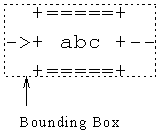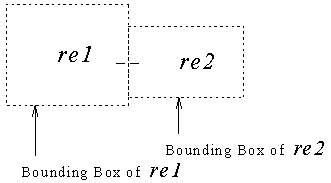
Note that the graphical representation of every expression has a bounding box. This is the smallest rectangle that surrounds the graphic.

The two expressions re1 and re2 have to be concatenated such that the bounding boxes of the two expressions touch and such that the '-' on the right of re1 matches the '-' on the left of re2.

the number of '|' characters that has to be added depends on the shapes of re1 and re2. There has to be exactly one straight blank line between the bounding box of the graphical representation of re1 and the bounding box of re2. If necessary, also a number of '-' characters has to be added on the right side of re1 or re2, to make the drawing possible. Note that the '-' on the left of re1 and re2 matches the '\' character and that the '-' on the right of re1 and re2 matches the '\' character in the drawing.

Note that the '-' on the left of re1 matches the '\' character and that the '-' on the right of re1 matches the '/' character in the drawing.
For example the graphical representation for the regular expression
{("f" "bar") ["c"]} looks like:
+===+ +=====+
---\->+ f +--->+ bar +--/-->
| +===+ +=====+ |
| |
| /---------\ |
| | +===+ | |
\-\->+ c +--/--------/
+===+
Input Specification
The input consists of a line holding the number of test cases, followed by the input expressions (one per line). The expressions are formatted according to the following grammar:expression :: sequence | alternatives | repetition | terminal
sequence :: ( ws expression expression ) ws
alternatives :: { ws expression expression } ws
repetition :: [ ws expression ] ws
terminal :: " character* " ws
ws :: (< space > | < tab >)*
character :: <any character except " and control-characters (ASCII 0..31)>
Note that the grammar is specified according to the following notational conventions:
- x y
- sequence: x followed by y
- x | y
- choice: x or y
- x*
- repetition: zero or more occurrences of x
- < >
- used for describing a character
Output Specification
For each expression, output a line of the form XxY with X and Y the width and height of the graphical representation of that expression.
Example Input
1
{("f" "bar") ["c"]}
Example Output
28x8
This page maintained by Ed Karrels.
Last updated January 3, 1998